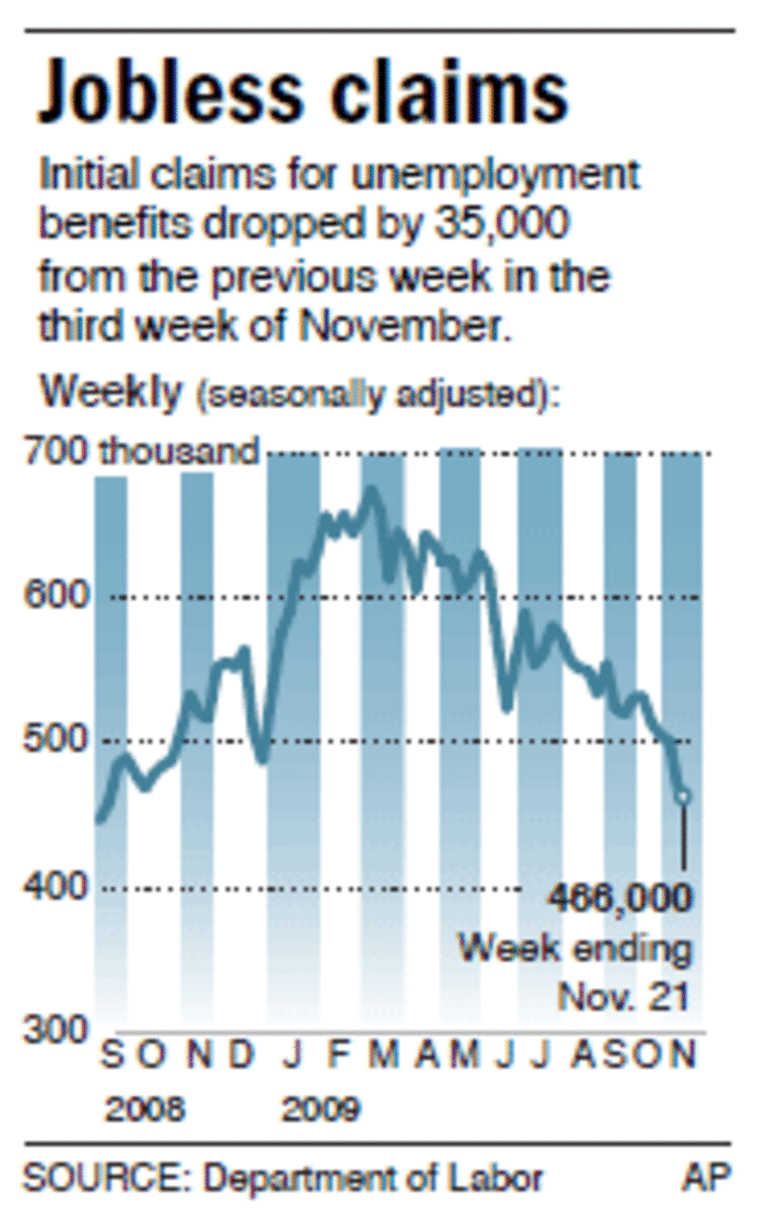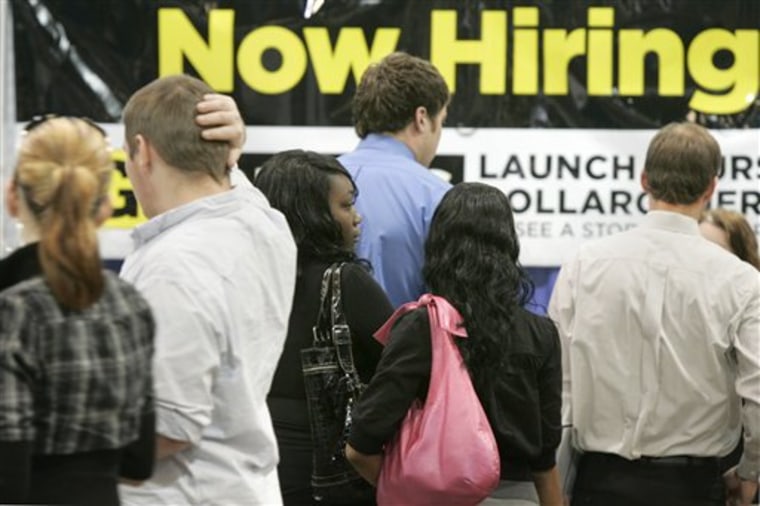In a hopeful sign for the economy, the number of newly laid-off workers filing claims for unemployment benefits fell below 500,000 last week for the first time since January.
Consumer spending picked up in October, new-home sales hit their highest point in more than a year and shoppers' outlook brightened a bit ahead of the crucial holiday shopping season.
Combined, the news suggested that the economy should be able to sustain at least a modest rebound. Some economists have worried that the economy was at risk of slipping back into recession.
The number of people filing first-time claims for jobless aid fell by 35,000 to 466,000, the Labor Department said Wednesday. That was the fewest since September of last year. And it was far better than the 500,000 economists had expected.
Still, analysts noted that jobless claims would have to drop to near 400,000 for several weeks to signal actual growth in employment.
Economists estimate the economy will lose a net 145,000 jobs this month. It would have to add 125,000 jobs a month just to keep the unemployment rate from rising.
Some economists sounded cautionary notes about Wednesday's positive news. They say the sluggish recovery could limit further improvements in jobless claims, new-home sales and consumer spending, which powers 70 percent of the economy.
"When taken all together, the reports still paint a picture of a slow economic recovery," said Mark Vitner, an economist at Wells Fargo.
Durable goods orders fell
One such sign was that orders for costly manufactured goods fell unexpectedly last month. Much of October's weakness came from a big drop for goods related to defense. Excluding those, orders for other types of manufactured goods rose slightly. Still, the overall performance was weaker than economists had expected.
Some analysts also cautioned against reading too much into the sharp drop in unemployment claims. They noted that part of the improvement reflected large seasonal adjustment factors, which smooth out changes that normally occur at certain times of the year. Excluding seasonal adjustments, claims rose. That's normal at this time of year when many construction workers face layoffs because of worsening weather conditions.
Most economists say the recovery will remain so weak and job creation so slight that the unemployment rate will keep rising. Many think the rate, which hit a 26-year high of 10.2 percent in October, could top 10.5 percent by mid-2010. Federal Reserve policymakers expressed concern at their November meeting that the rate could remain elevated for several years, according to minutes of the discussions released Tuesday.

Analysts also noted that the surge in new-home sales was driven entirely by a 23 percent increase in the South. Sales in all other regions fell.
Encouraging signs
Still, taken together, the reports on jobless claims, consumer spending and home sales were encouraging, and stock prices rose in light volume on Wall Street.
New jobless claims dropped below 500,000 for the first time since the first week in January. Weekly claims peaked at 674,000 in March and have since been trending lower.
Consumer spending rose a 0.7 percent last month, following 0.6 percent drop in September, the Commerce Department said. It was the best showing since a big 1.3 percent jump in August when the government's now-defunct Cash for Clunkers programs enticed people to buy cars.
Incomes, the fuel for future spending, rose 0.2 percent for the second straight month.
Consumers spent more on costly "durable" manufactured goods — such as cars and appliances. Such spending rose 2.1 percent. They also boosted spending last month on "nondurables," including food and clothes, and on services.
Double-dip
Wednesday's figures seemed to blunt some fears that consumers could clam up, sending the country into a "double dip" recession.
Yet concerns remain that consumer spending will slow early next year.
Consumer sentiment improved slightly in November from earlier in the month, but it was weaker than October as deep anxiety lingered over personal finances, a survey showed on Wednesday.
This uneasiness foreshadows another tough year-end holiday season for retailers, some of which already slashed prices to lure shoppers.
The Reuters/University of Michigan Surveys of Consumers said the final figure for its index of consumer sentiment in November stepped up to 67.4 from 66.0 in the first half of the month.
Analysts had expected a final November figure of 67.0, compared with a final October reading of 70.6.
"The decline in consumer confidence was due to grim assessments by consumers of their finances, the worst ever recorded in the 60-year history of the surveys," Richard Curtin, director of the survey, said in a statement.
Savings rate dips
With spending outpacing income growth, Americans' personal savings rate — savings as a percentage of after-tax income — dipped to 4.4 percent in October from 4.6 percent in September.
Personal income from interest came to an annualized $1.23 trillion, ticking up 0.5 percent from September. People who rely on interest from savings, such as money in certificates of deposit, have been seeing their income fall for months, raising doubts about their ability to spend.
New-home sales rose 6.2 percent to a seasonally adjusted annual rate of 430,000 from an upwardly revised 405,000 in September. Economists had expected a pace of 410,000. Home shoppers were acting before lawmakers decided this month to extend a tax credit for first-time buyers and expand it to some existing homeowners.
Much of October's weakness in durable-goods orders came from an 18.4 percent drop in orders for goods related to defense. Excluding those, orders for other types of manufactured goods rose 0.4 percent in October, after a 1.8 percent rise in September.
Orders for electrical equipment, commercial airplanes and parts, primary metals — including steel — and fabricated metals all rose last month. Orders for cars, machinery, computers and communications equipment fell.
A drop of 190,000 in the number of people continuing to claim jobless aid marked the 10th consecutive decline, leaving it at 5.42 million, the lowest level since the week of Feb. 28. The continuing claims figure, though, does not include millions who have used up the regular 26 weeks of benefits typically provided by states and are receiving extended benefits for up to 73 additional weeks.
